
Chapter 1
Shifting growth priorities
Accelerating growth is vital for tech companies to make a successful switch.
EY teams highlighted previously the importance for tech companies to change their organization and operating model to accelerate growth. The sales and marketing functions are at the heart of this transformation, as the de facto custodians of their businesses’ growth agendas. This role sees several emerging items dominating their priority list, especially now.
As EY research shows, the “top five” of sales and marketing leaders’ priorities shows a growing focus on customer intimacy and experience while expanding sales of services and SaaS propositions. Companies’ top strategic objective is now to increase their sales of services – driving growth while achieving greater predictability of revenue through service-based business models. Close behind at number two is improving the customer experience – maximizing relevance and value creation for the customer by constantly removing friction from all their interactions with the business.
Emerging priorities and challenges
Tech companies’ strategic objectives are now focused on service sales and customer experience – and their main challenges reflect the barriers to those objectives.
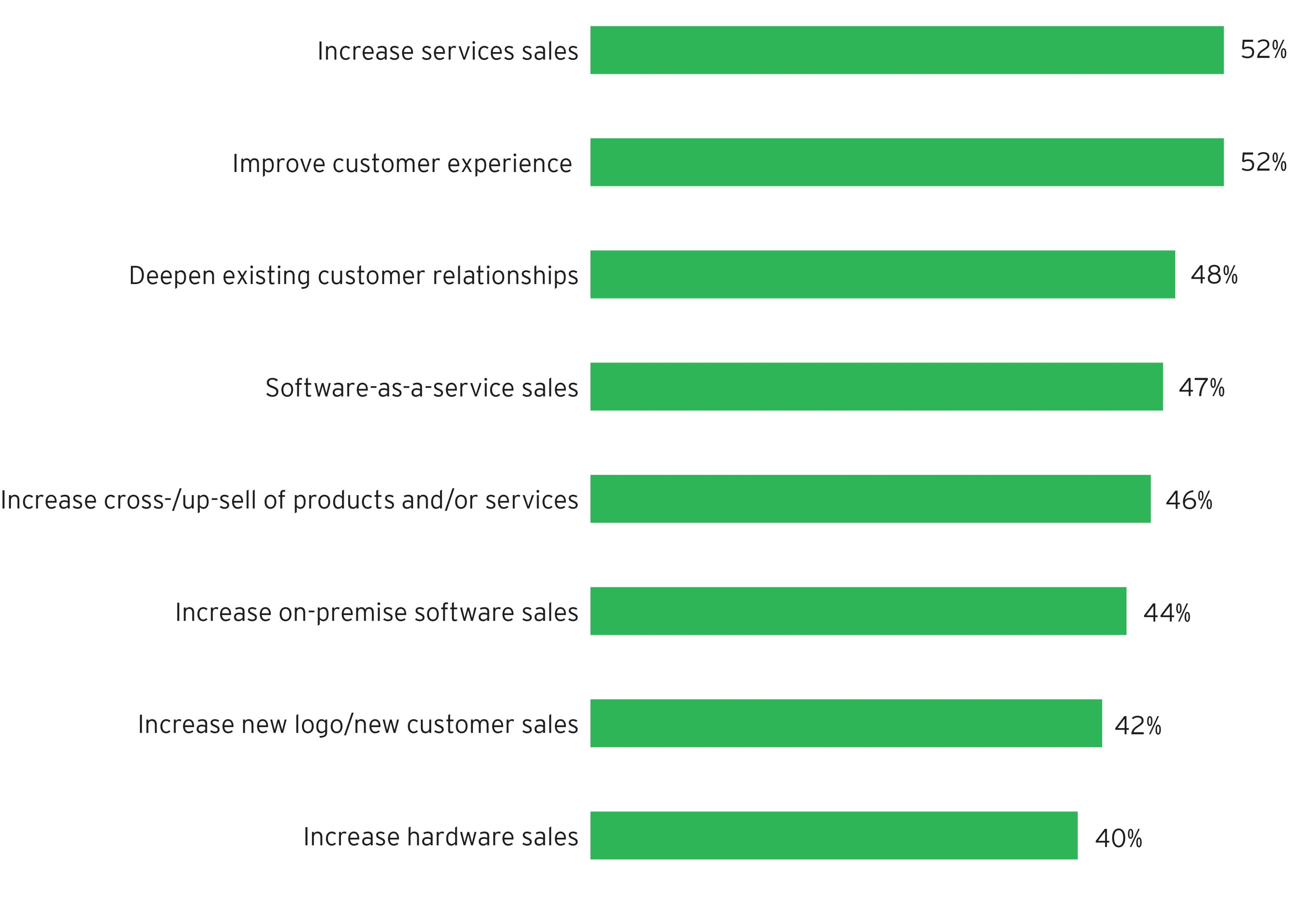
What are the strategic sales and marketing objectives that your organization is trying to achieve?
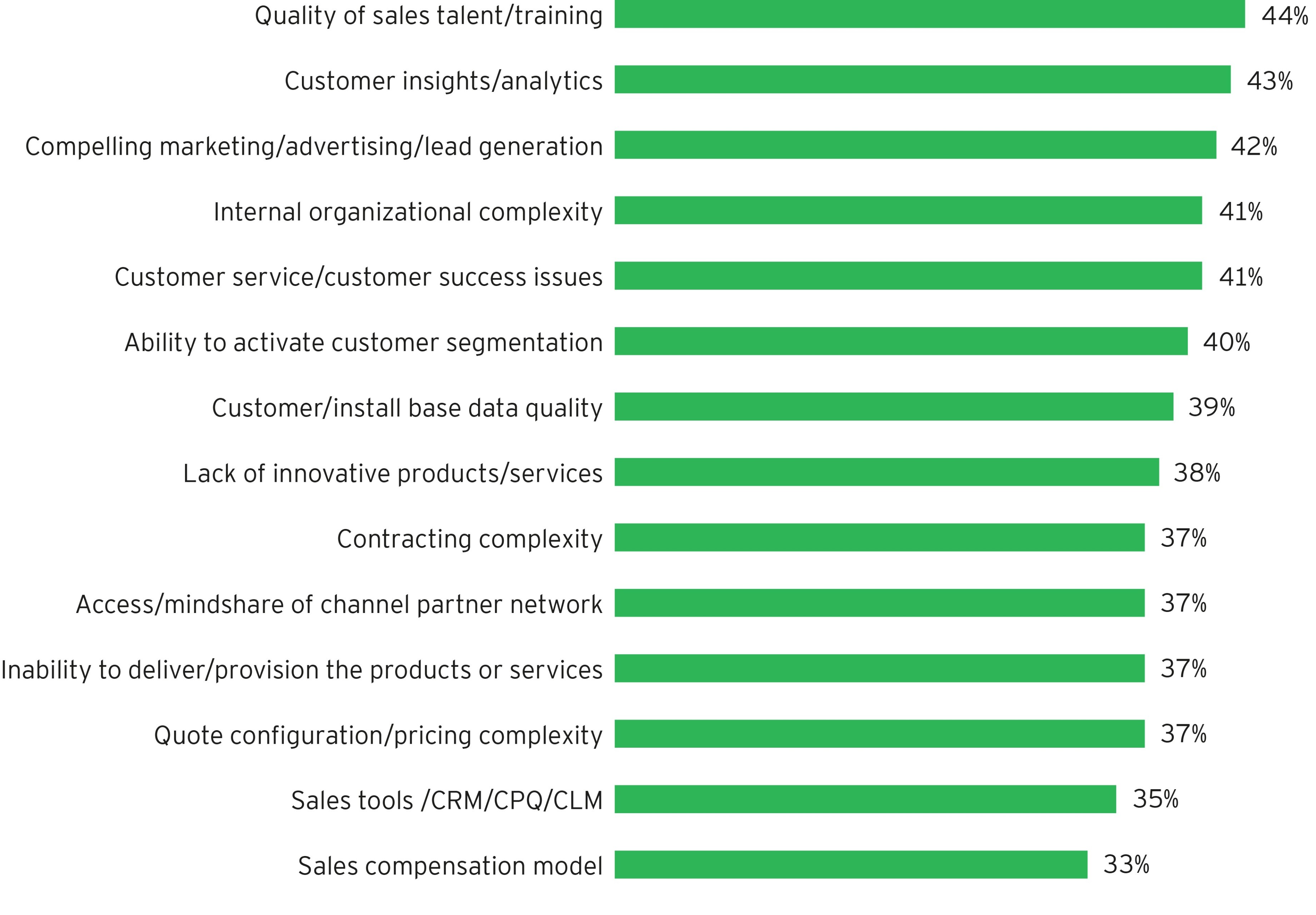
Key factors impeding the ability to achieve your organization's growth objectives
Underline the shift to customer experience and consumption
The twin goals of enhancing sales of consumption-based services and customer experience are not unrelated. The advent and increasingly ubiquitous nature of consumption-based business models – subscription, usage, or engagement– is maximizing the importance of the customer experience.
The reason? Switching to a consumption-based business model dramatically increases the number of touch points between customer and company. And differentiated, personalized and relevant experiences must be provided throughout the entire customer lifecycle – through first purchase, upsell/upgrade, renewal/retention, and loyalty. There are also risks associated to that: in a business model built on rewarding ongoing relevance and value creation, customers are always one click away from switching provider and immediately switching off revenue streams to them. Every interaction can turn into a moment of truth. It is therefore essential to make sure to provide an optimized experience at every touchpoint
But companies have a lot to do to achieve this. Some 45% are not sure they have the right processes and data strategy to enable a seamless customer experience. And the biggest challenge to ensuring a consistent experience is a lack of customer insights/data.
Challenges to reinventing the customer experience
Almost half of tech companies are unconvinced that they have the data strategy and tools to provide the right customer experience.
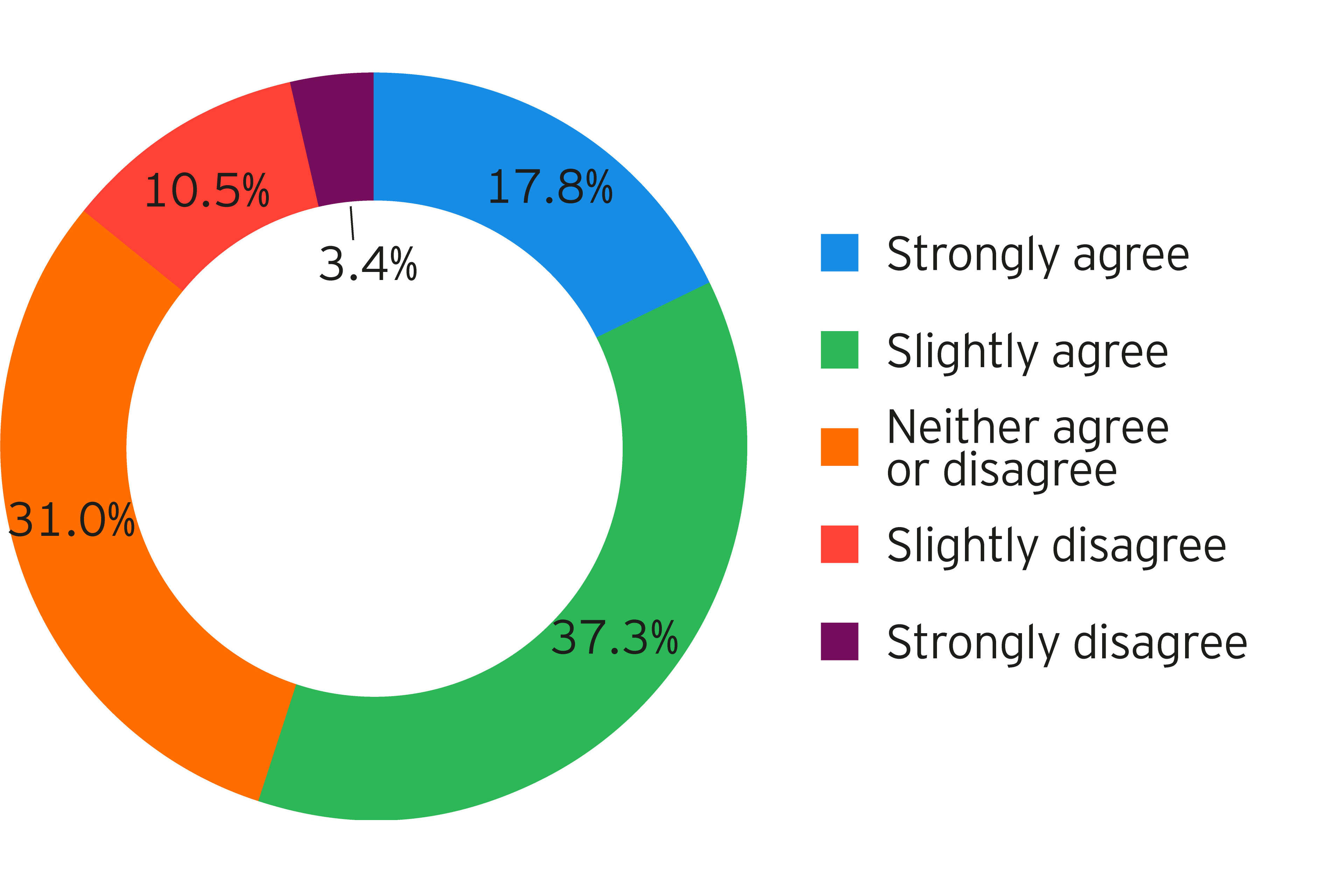
My organization has the right data strategy and tools in place for marketing, sales, services and customer success to enable a seamless customer experience
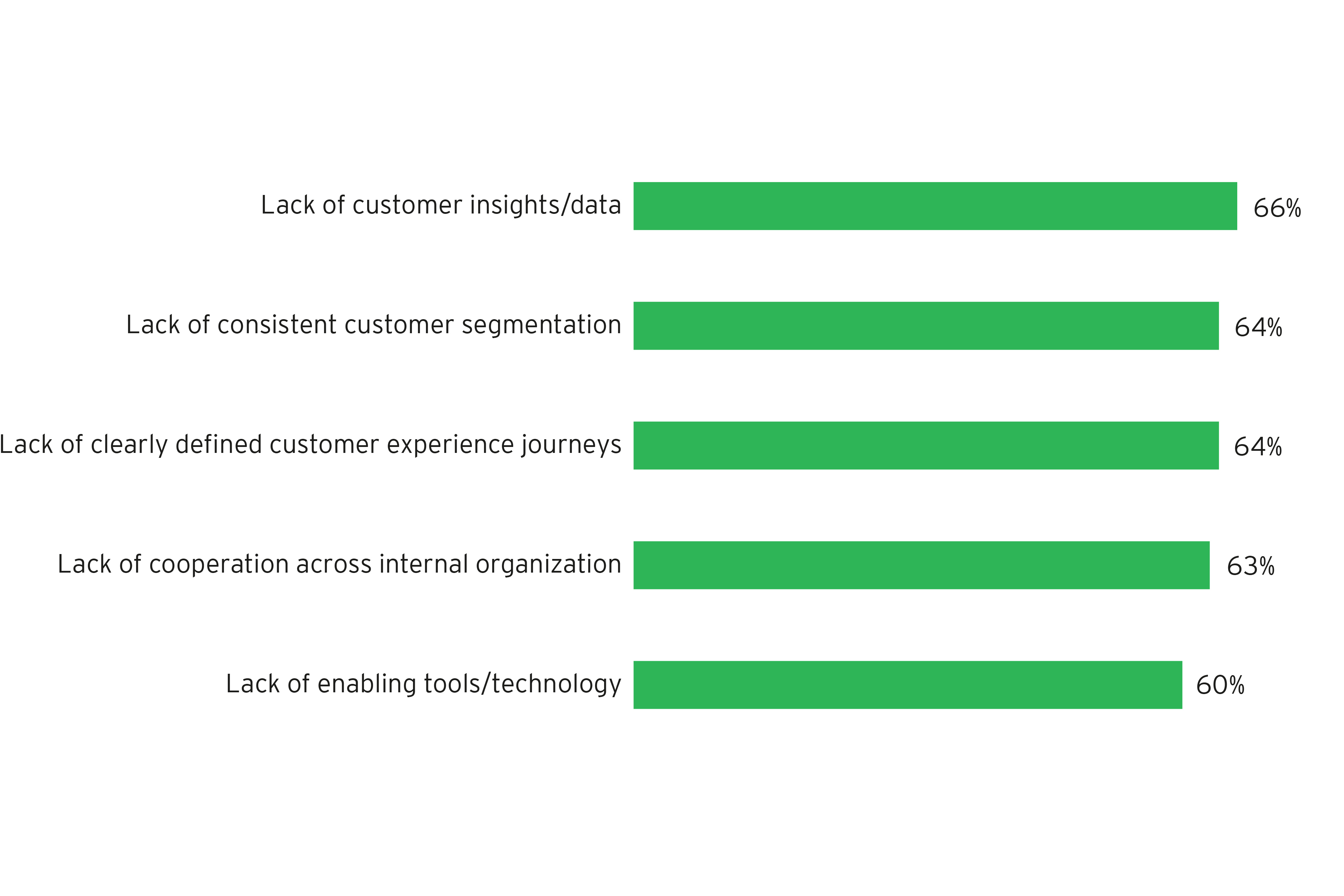
What do you see as the greatest challenge(s) within your organization to ensure a consistent customer experience?

Chapter 2
Engage customers the way they want to be engaged
In this new world, customer experience isn’t just the new battleground, but the entire proposition.
Principles for a winning customer experience
By analyzing the findings from the growth leaders in our study (tech firms that have achieved greater than 10% of topline growth over a sustained period of time), EY teams have identified five principles for developing a customer experience that helps maximize growth under an engagement-based model:
Engage the customers the way they want to be engaged
Align front office roles across the end-to-end customer lifecycle, with a focus on being connected, insightful and responsive – all the way from initial discovery up to and beyond the point of sale.
Growth leaders feel more confident about how connected their front office is to deliver on customer experience objectives: they’re 50% more likely than average to strongly agree that they provide a seamless experience across marketing, sales and service. This enables them to push further ahead in shifting to consumption-based business models, with 76% stating they are either in progress or have fully shifted, compared with less than 60% on average.
Engage the customers the way they want to be engaged

My organization has clear established process across marketing, sales and services that enable a seamless experience for customers
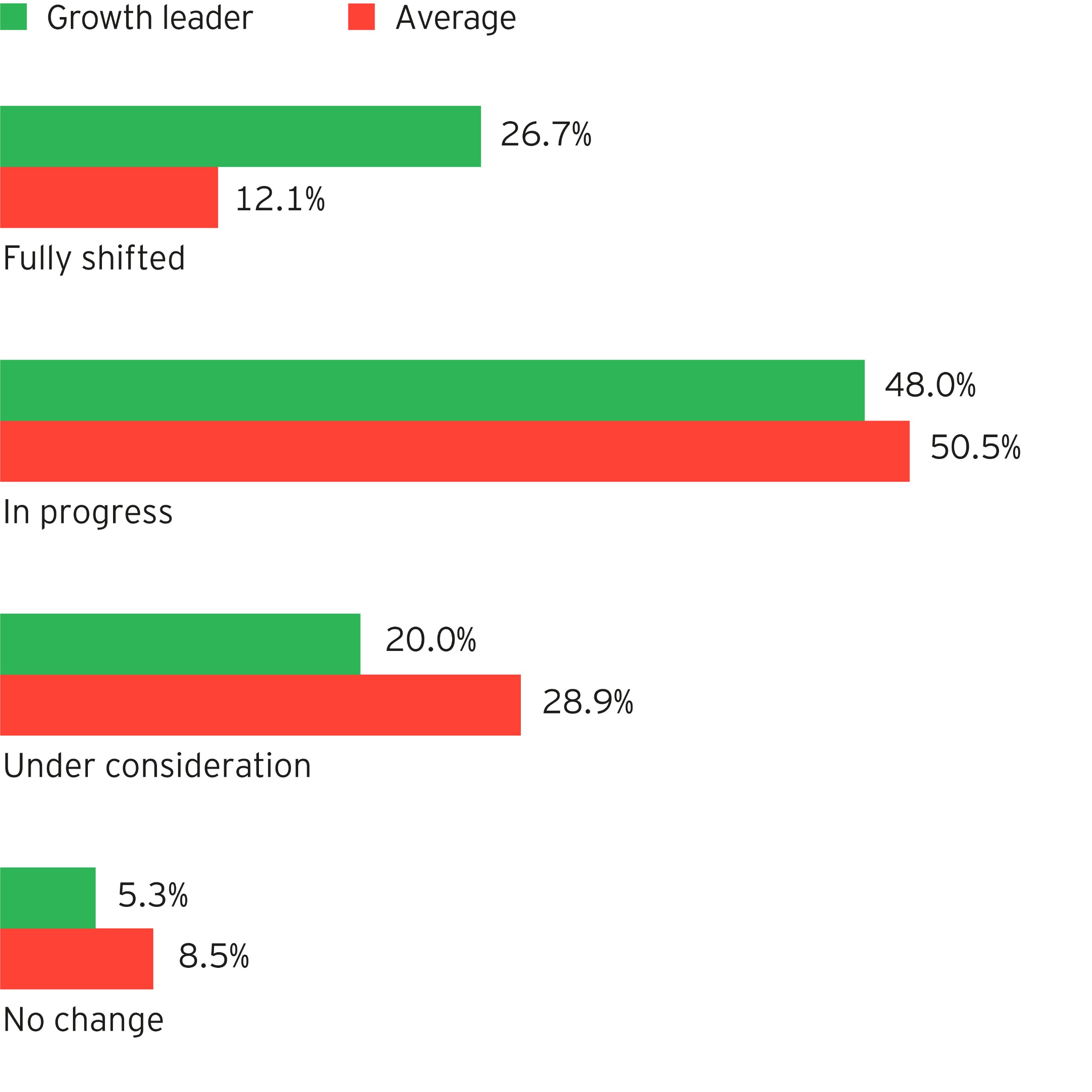
Which of the following best describes your organization's shift to a service/subcription model?
1. Put the right talent in the right place
Align current and future talent to roles where they can have the most impact from a business and personal perspective, while providing compelling career journeys.
Sales and marketing leaders identify the quality of sales talent and training as their main obstacle to growth. And specifically, for the activation of consumption-based business models, the departments that come top for upskilling needs are customer success and customer support and service.
However, growth leaders are considerably more confident than average on the ability of their sellers to have value-based conversations (28% strongly agree versus 17% on average) and the availability of their sales enablement training (29% versus 20%). Having evolved their solution selling skills quicker, their top skills gap is around building awareness of new pricing models and commercial acumen across the salesforce.
Put the right talent in the right place
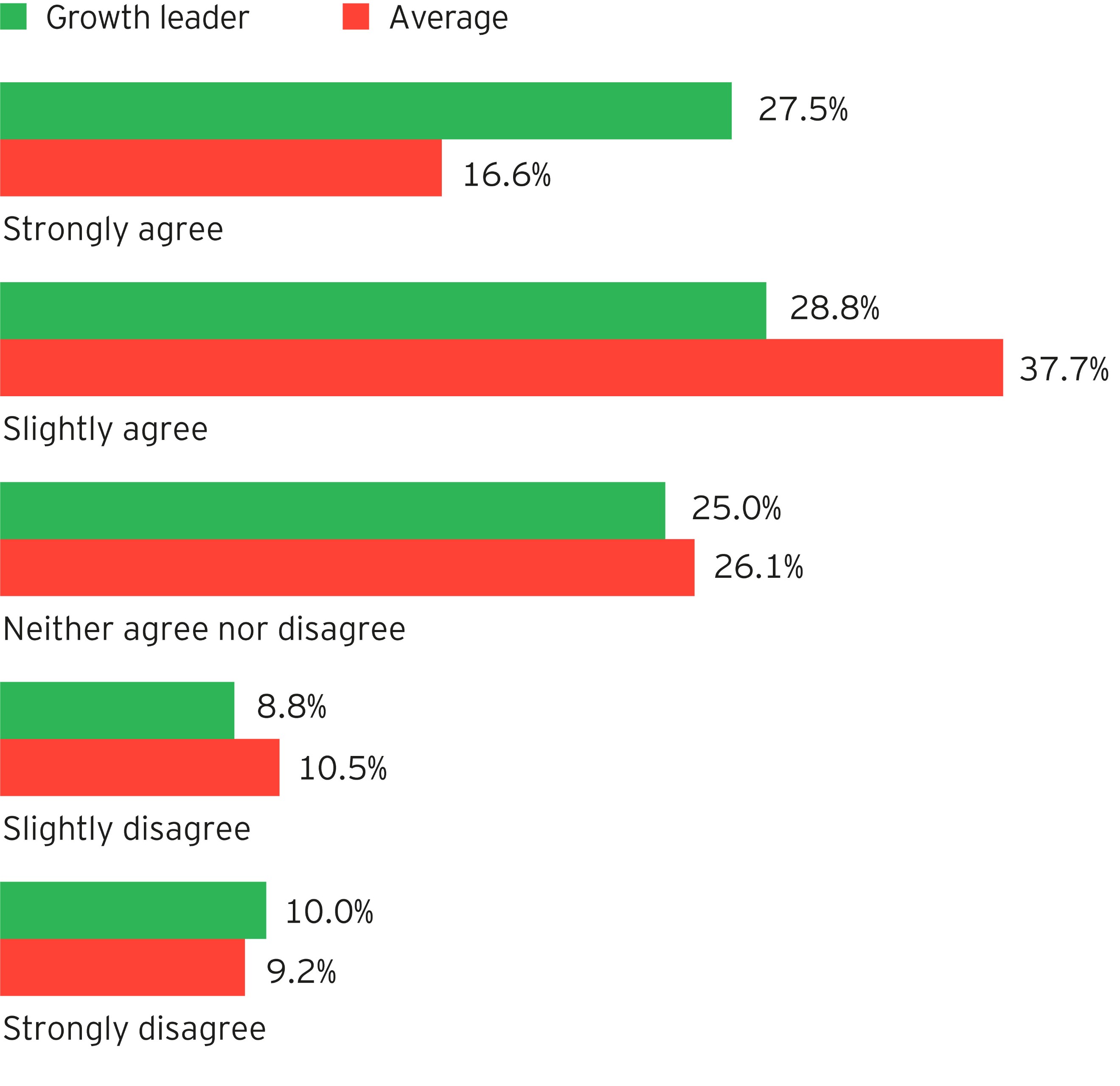
Sellers at my organization are positioned to have a value-based discussion with our clients
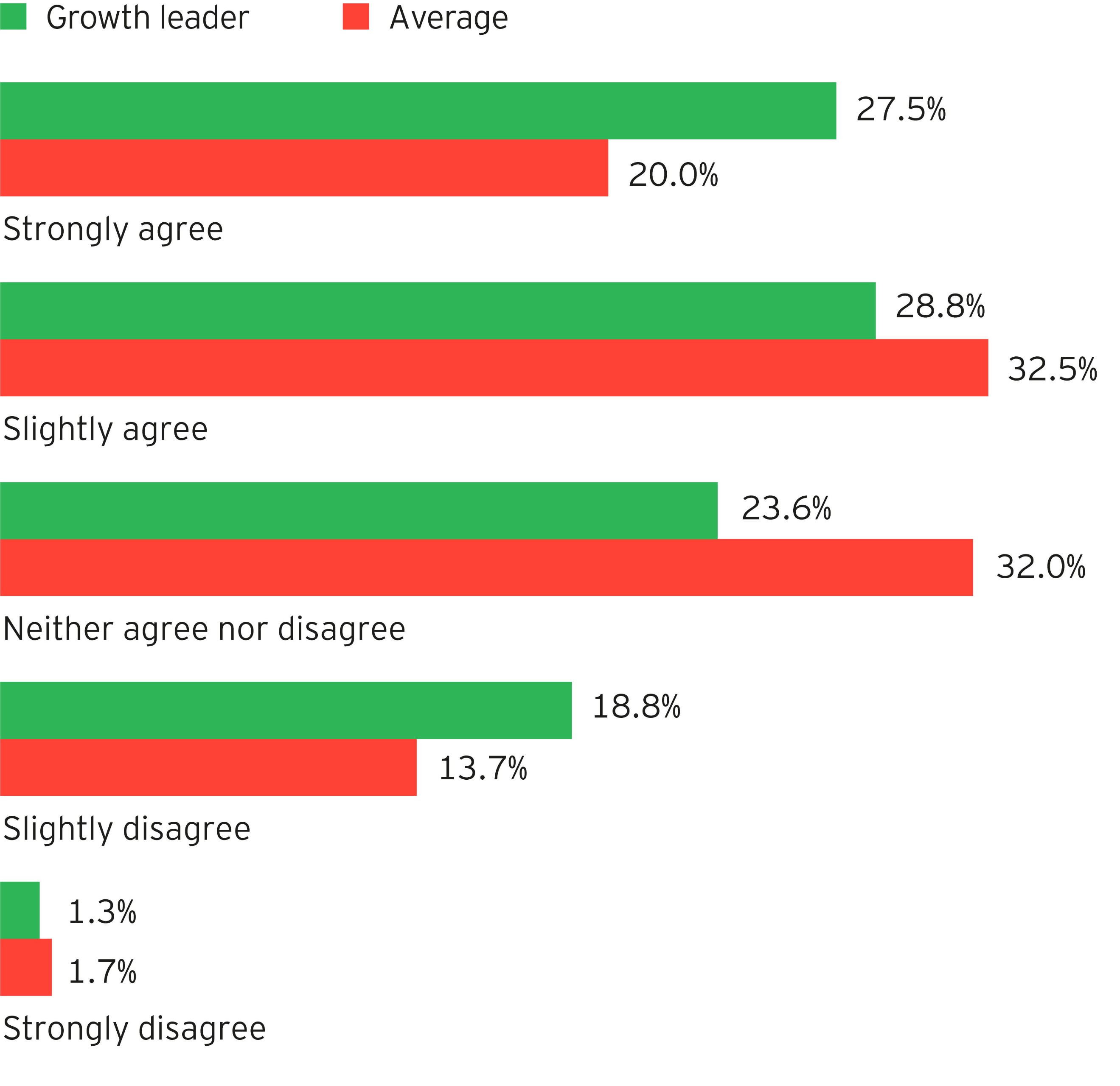
My organization has the right sales skill enablement programs in place to eduate my sales teams on the mindset of the modern buyer
2. Use analytics to make better decisions, faster
Analyze internal and external data to generate insight which informs and predicts future performance, enabling better decisions on the use of resources.
Growth leaders are much more confident than the average about their ability to achieve better customer insight and thereby drive customer intimacy. They’re almost twice as confident in their tools and processes for understanding customer needs – only 42% of growth leaders think these are not effective, against an average of 71%. This is also reflected in the data they use to understand customers. While “the average” firm still focuses primarily on sales data and insight provided qualitatively by the sales force, growth leaders prioritize data derived from the actual use of services as well as web and marketing analytics insight. Their focus, in short, is data that’s a closer indicator of how the customer interacts with services and channels.
Use analytics to make better decisions, faster
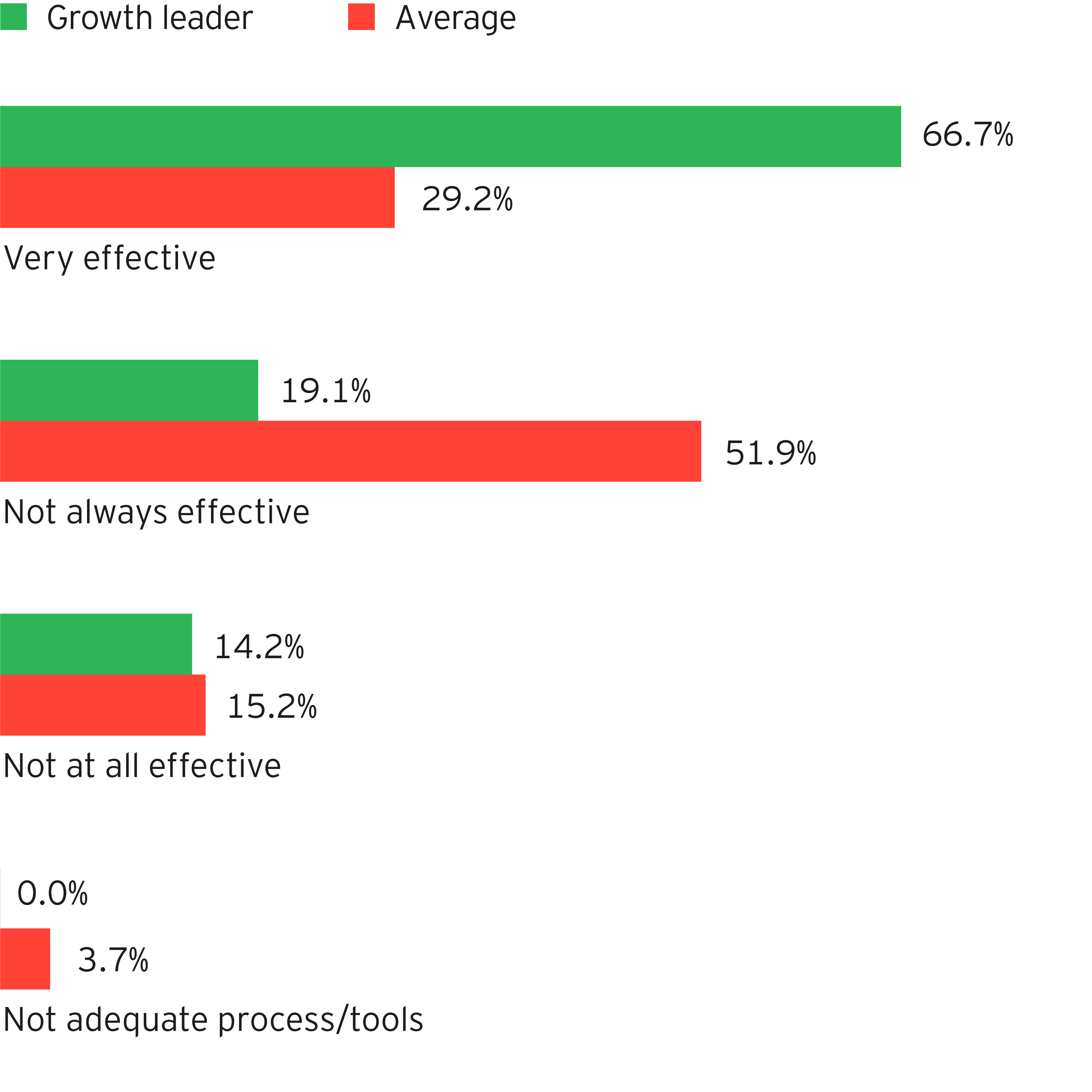
Tools/process to understand the custoner needs and expectations throughout the entire customer life cycle
3. Infuse digital into everything they do
Embed digital into the organizational culture by focusing on changing mindsets and providing assets to improve the employee and customer experience.
There’s broad acceptance that credible self-service options are a differentiator, with 55% agreeing – the same for growth leaders and companies overall. However, growth leaders are actually managing to shift significant volumes of business through digital channels: they’re three times more likely than the average to offer full self-service purchase capabilities for all products, and twice as likely for renewals and service modifications. But crucially, growth leaders are focusing not just on self-service models, but on overall digital enablement across the organization.
The most successful companies are investing disproportionately in technologies to digitally enable sales, marketing, finance and customer success/service, thus permitting digital end-to-end campaign-to-cash processes. These investments allow organizations to better understand buying behaviors, needs, adoption and consumption, ultimately enabling them to increase customer loyalty, reduce churn and unlock cross-sell/up-sell opportunities.
Infuse digital into everything they do
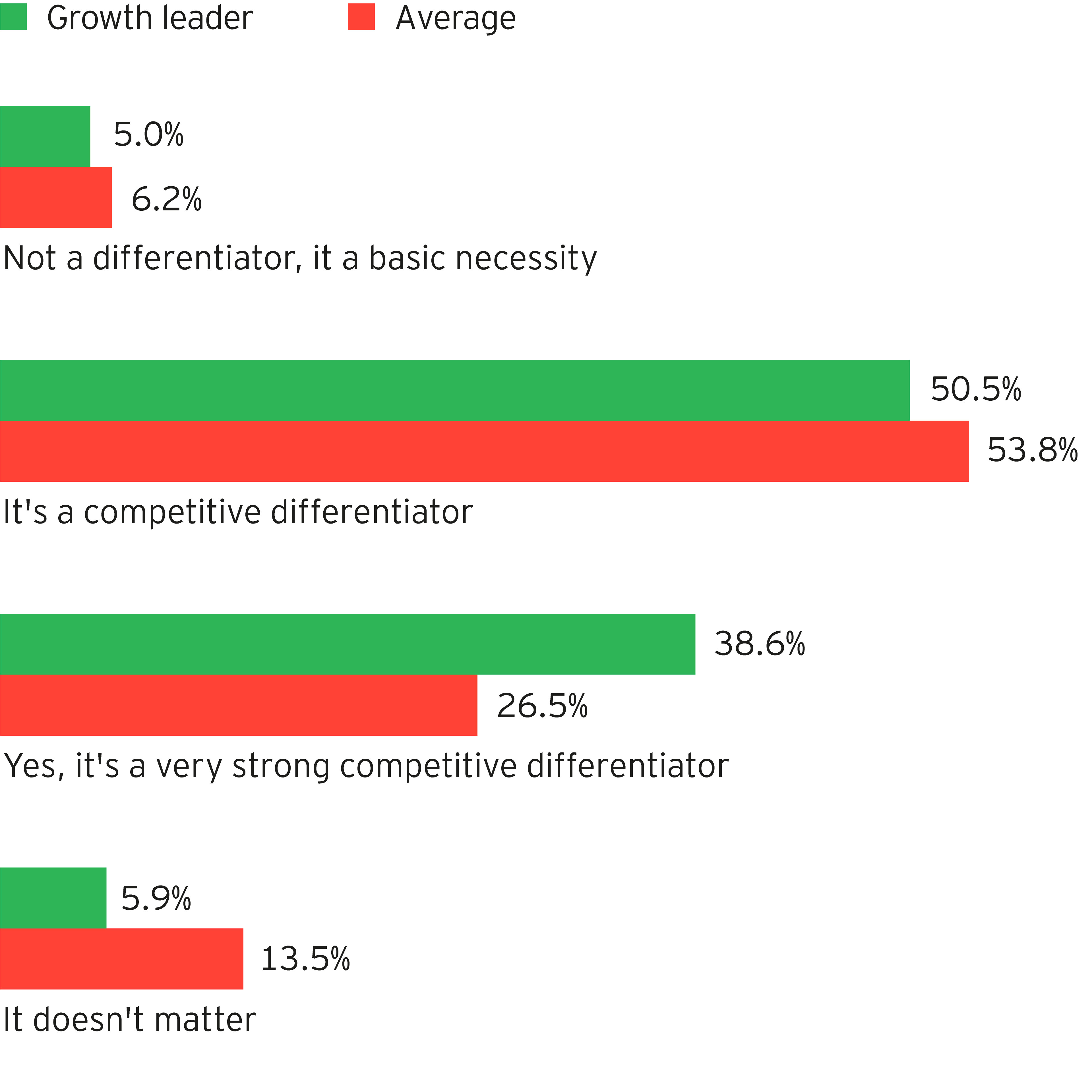
Is providing a self-service/e-commerce channel a key competitive differentiator for your organization
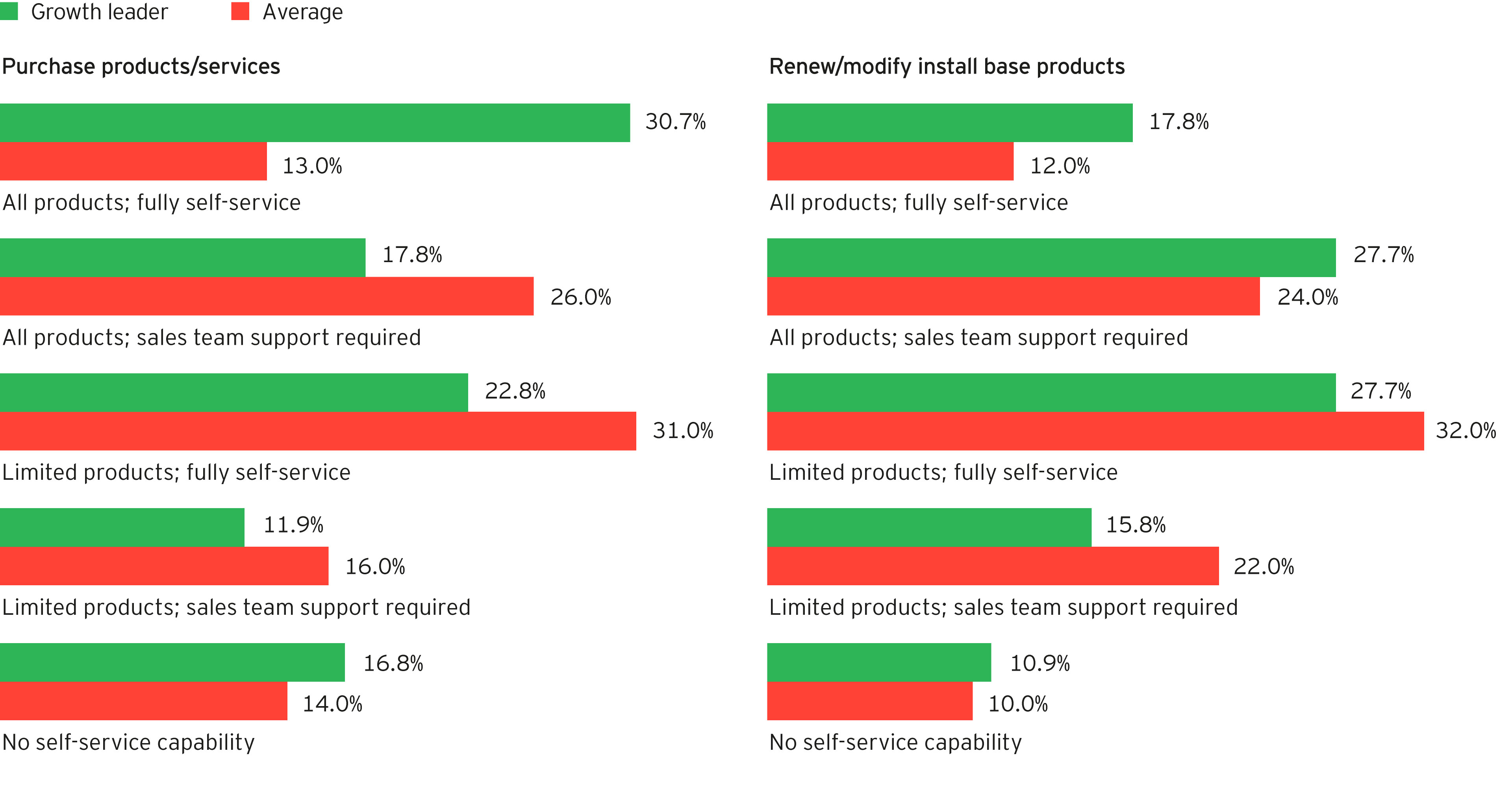
Indicate the extend to which your customers can leverage a self-service/e-commerce portal to?
4. Partner for maximum impact
Establish a confident position in the selected value chains and construct ecosystems that maximize customer value.
As the use of partnerships between different technology providers grows, challenges arise in providing a consistent customer experience in joint sales or delivery models. Technology providers overall cite the lack of a developed partner ecosystem as the top challenge around partnerships in ensuring a consistent customer experience. But growth leaders don’t even place this in their top five challenges. And they’re 50% more likely than average to feel happy about the strength of their partner ecosystem, the effectiveness of marketing support for partners, and the shape of their partner incentive structures.
Critical solutions to support your journey:
- Commercial transformation – by addressing organic growth issues at both strategic and operational levels with advanced analytics, EY teams help clients develop and implement transformational growth strategies geared to today’s disruptive and evolving marketplace.
- Digital strategy and transformation – DS&T brings together EY cross-service line capabilities and design, technology and innovation skills with our finance and risk insights and deep industry knowledge to help companies survive and thrive. EY was recognized as a leader in The Forrester Wave™: Global Digital Business Transformation Accelerators, Q1 2019.
Partner for maximum impact
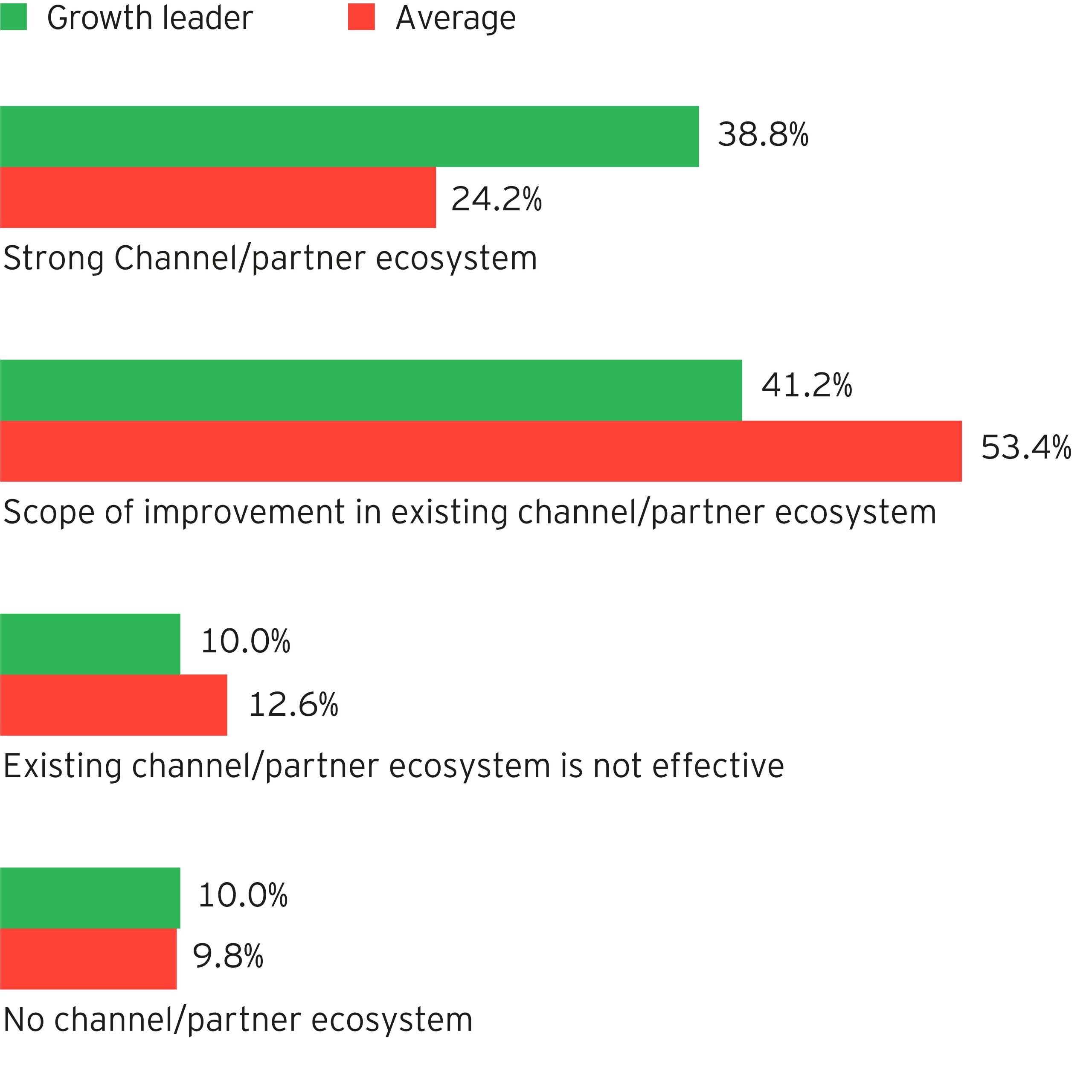
Does your organization have a partner and channel ecosystem that enables you to achieve your growth objectives?

Chapter 3
Getting it right
Overcoming quality of sales talent and training obstacles to maximize the success of your consumption-based business model.
Getting it right and getting started. Today.
By applying the five principles EY teams have proposed, you’ll position yourself to create a personalized, seamless, consistent customer experience that will help maximize the success of your consumption-based business model. This is something several leading companies have already achieved.
A leading provider of content and interactive workflow software to professional users partnered with EY to transform their front office and support an open-platform subscription-based business model – to support maximizing customer relevance and accelerating business performance across 40,000 customers in 190 countries. Since completion, the outcomes have included three consecutive quarters of budget-beating growth, an increase of 90%-plus in revenue retention and a 5% rise in customer advocacy.
A global provider of managed cloud computing solutions worked with EY to transform its customer experience by rethinking its “lead-to-online” process — introducing solutions-based sales, simplifying pricing, leveraging partner reselling models, while shortening sales and implementation times through automation and workflow management. The result was a reduction in the lead-to-online time from 80 days to less than 40 days.
Reinventing your customer experience to maximize consumption-based business performance doesn’t have to be a difficult or protracted process. EY’s global network of Wavespace™ locations move fast to provide breakthrough thinking and detailed, practical services – helping you give your customers the compelling, consistent experience they want and deserve.
Summary
Especially now, tech companies are increasingly looking for differentiation and growth by aligning their business models more closely to the actual consumption of their products and services. In this new world, customer experience isn’t just the new battleground, but the entire proposition. Sales and marketing leaders need to lead the charge in achieving customer relevance and value. Yet almost half of survey respondents aren’t sure they have the right business processes and strategy to enable the differentiated, personalized and relevant customer experiences required for success. EY pinpointed five principles for creating the right customer experience for the new growth era.
